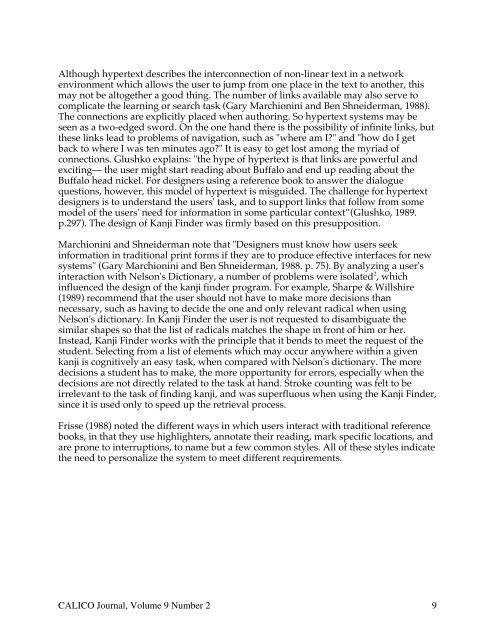Kanji Retrieval by Recursive Location of Elements Using HyperCard
Kanji Retrieval by Recursive Location of Elements Using HyperCard
Kanji Retrieval by Recursive Location of Elements Using HyperCard
Create successful ePaper yourself
Turn your PDF publications into a flip-book with our unique Google optimized e-Paper software.
Although hypertext describes the interconnection <strong>of</strong> non-linear text in a network<br />
environment which allows the user to jump from one place in the text to another, this<br />
may not be altogether a good thing. The number <strong>of</strong> links available may also serve to<br />
complicate the learning or search task (Gary Marchionini and Ben Shneiderman, 1988).<br />
The connections are explicitly placed when authoring. So hypertext systems may be<br />
seen as a two-edged sword. On the one hand there is the possibility <strong>of</strong> infinite links, but<br />
these links lead to problems <strong>of</strong> navigation, such as "where am I?" and "how do I get<br />
back to where I was ten minutes ago?" It is easy to get lost among the myriad <strong>of</strong><br />
connections. Glushko explains: "the hype <strong>of</strong> hypertext is that links are powerful and<br />
exciting— the user might start reading about Buffalo and end up reading about the<br />
Buffalo head nickel. For designers using a reference book to answer the dialogue<br />
questions, however, this model <strong>of</strong> hypertext is misguided. The challenge for hypertext<br />
designers is to understand the users' task, and to support links that follow from some<br />
model <strong>of</strong> the users' need for information in some particular context”(Glushko, 1989.<br />
p.297). The design <strong>of</strong> <strong>Kanji</strong> Finder was firmly based on this presupposition.<br />
Marchionini and Shneiderman note that "Designers must know how users seek<br />
information in traditional print forms if they are to produce effective interfaces for new<br />
systems" (Gary Marchionini and Ben Shneiderman, 1988. p. 75). By analyzing a user's<br />
interaction with Nelson's Dictionary, a number <strong>of</strong> problems were isolated 2 , which<br />
influenced the design <strong>of</strong> the kanji finder program. For example, Sharpe & Willshire<br />
(1989) recommend that the user should not have to make more decisions than<br />
necessary, such as having to decide the one and only relevant radical when using<br />
Nelson's dictionary. In <strong>Kanji</strong> Finder the user is not requested to disambiguate the<br />
similar shapes so that the list <strong>of</strong> radicals matches the shape in front <strong>of</strong> him or her.<br />
Instead, <strong>Kanji</strong> Finder works with the principle that it bends to meet the request <strong>of</strong> the<br />
student. Selecting from a list <strong>of</strong> elements which may occur anywhere within a given<br />
kanji is cognitively an easy task, when compared with Nelson's dictionary. The more<br />
decisions a student has to make, the more opportunity for errors, especially when the<br />
decisions are not directly related to the task at hand. Stroke counting was felt to be<br />
irrelevant to the task <strong>of</strong> finding kanji, and was superfluous when using the <strong>Kanji</strong> Finder,<br />
since it is used only to speed up the retrieval process.<br />
Frisse (1988) noted the different ways in which users interact with traditional reference<br />
books, in that they use highlighters, annotate their reading, mark specific locations, and<br />
are prone to interruptions, to name but a few common styles. All <strong>of</strong> these styles indicate<br />
the need to personalize the system to meet different requirements.<br />
CALICO Journal, Volume 9 Number 2 9
















